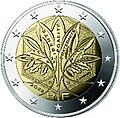French euro design
For images of the common side and a detailed description of the coins, see euro coins.
The first sets of euro coins were minted in 1999 and the euro was put into circulation in the eurozone in 2002. Like Belgium, Finland, the Netherlands and Spain, the first euro coins of France are marked 1999, not 2002.
To coincide with the French Presidency of the Council of the European Union, and the 20th anniversary of euro coins, the French national designs on the 1 and 2 euro coins have been changed. The new designs were approved by the Council of the European Union on 26 July 2021 and have been revealed to the public on 16 December 2021 ahead of their entry into circulation in 2022. [1] [2]
In 2024, new designs for the 10-, 20-, and 50-cent coins will be introduced, featuring Simone Veil on the 10-cent, Josephine Baker on the 20-cent, and Marie Curie on the 50-cent coin. [3]
Depiction of French euro coinage | Obverse side| €0.01 | €0.02 | €0.05 |
|---|
 |  | Link to file |
| Portrait of Marianne, the symbol of the first French Republic. |
| €0.10 | €0.20 | €0.50 |
|---|
 | Link to file | Link to file |
1999–2023: The sower, a theme maintained from the former franc.
2024–: The sower; Simone Veil | 1999–2023: The sower, a theme maintained from the former franc.
2024–: The sower; Josephine Baker | 1999–2023: The sower, a theme maintained from the former franc.
2024–: The sower; Marie Curie |
| €1.00 | €2.00 | €2 Coin Edge |
|---|
| Link to file | Link to file
 |  for a total of 12 stars for a total of 12 stars |
1999–2021: A stylised tree contained in a hexagon with the motto Liberté Egalité Fraternité.
2022–: The design features oak and olive branches that form the tree of life and symbolise strength, solidity and peace. The tree and the motto stand within a hexagon. |
French series 2024 Summer Olympics
This page is based on this
Wikipedia article Text is available under the
CC BY-SA 4.0 license; additional terms may apply.
Images, videos and audio are available under their respective licenses.




